How to Cut Out Sugar: Easy Tips to Break Sweet Addiction
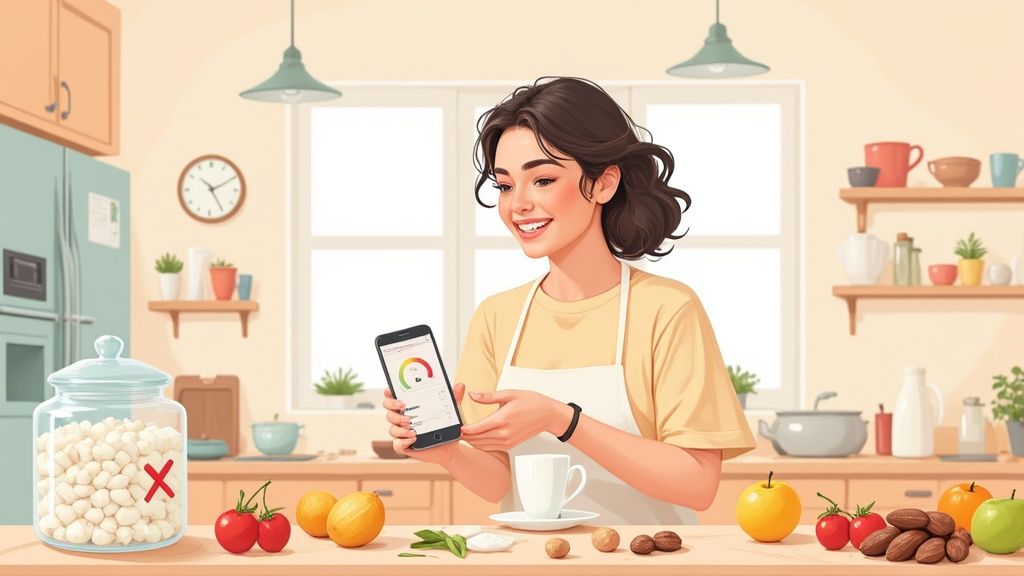
Why Your Sugar Cravings Feel So Impossible to Beat
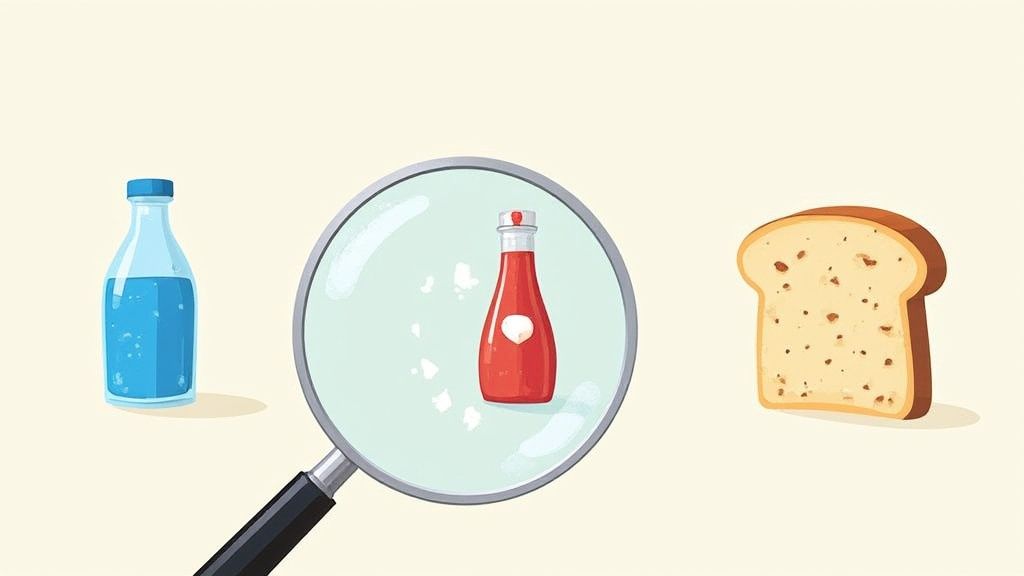
Let's be honest, fighting off sugar cravings isn't just about willpower. It's a battle against your own biology! That afternoon urge for a cookie isn't because you're weak; it's because food companies are masters at manipulating your brain's reward system. They've figured out how to create cravings that are incredibly hard to resist.
Think about it: when was the last time you craved broccoli the way you crave a chocolate bar? This isn't by chance. Sugar sets off a chain reaction in your brain, releasing dopamine and creating a feeling of pleasure. This reinforces the craving, making you want more and more. It's a vicious cycle.
This is why going cold turkey, although it seems straightforward, so often fails. You're basically depriving your brain of something it's become dependent on, which leads to intense withdrawal and a higher chance of you falling off the wagon.
Understanding Your Cravings
Sugar cravings are often linked to emotional eating. When we're stressed, bored, or feeling down, reaching for something sweet can offer temporary comfort. This is because sugar can actually dull the body's stress response, making it even more appealing as a coping mechanism. Figuring out your own personal triggers – whether it's stress, boredom, or certain times of day – is a crucial step in learning how to effectively cut sugar out.
The Global Sugar Overload
Cutting back on sugar is also becoming more urgent considering how much sugar people around the world are consuming, and the health risks that come with it. Let's look at some actual numbers to get a better picture of the situation. The table below compares average daily sugar intake in different countries with the recommendations from the World Health Organization (WHO).
Daily Sugar Intake: Reality vs. Recommendations
| Country | Daily Sugar Intake (grams) | WHO Recommendation (grams) | Times Over Limit |
|---|---|---|---|
| United States | 126.4 | <25 | >5 |
| Germany | 102.9 | <25 | >4 |
| United Kingdom | 96.2 | <25 | >3 |
| Mexico | 77.3 | <25 | >3 |
| China | 15.8 | <25 | <1 |
As you can see, the difference between how much sugar people are actually eating and what's recommended is pretty shocking in many countries. The United States, for example, consumes over five times the recommended amount! This overconsumption highlights the importance of addressing sugar cravings head-on. You can find more information on global sugar consumption here. Also, check out this helpful article on how to stop sugar cravings. This biological and emotional link we have with sugar is exactly why understanding the why behind those cravings is the first, and probably most important, step in taking back control.
Uncovering Sugar's Hidden Hiding Spots in Your Food
Okay, so let's talk sugar. And I mean the hidden sugar, the kind lurking in places you'd never suspect. Get ready, because you might be surprised at what we find on this little virtual grocery store tour. We're about to expose how sugar hides in plain sight, even in foods we often think of as healthy. Think granola bars, yogurt, even that jar of pasta sauce you grabbed on your last shopping trip.
There are over 60 different names for sugar. Seriously! Food manufacturers have gotten really creative. They use terms like "fruit juice concentrate," "organic brown rice syrup," and "evaporated cane juice." Sounds natural, right? Don't be fooled. It's all still sugar.
Decoding Food Labels
If you're serious about cutting back on sugar, you have to become a label-reading detective. Let me give you an example. That "natural" salad dressing in your fridge? It might brag about being low-fat, but check the sugar content. You might be shocked. Same goes for yogurt. Those fruit-flavored ones can be loaded with added sugar to make up for the tartness of the fruit. All those little bits of added sugar really add up and can trigger cravings, making it harder to reach your health goals.
Here’s a quick reminder of what to look for on the Nutrition Facts label, courtesy of the FDA:
Pay close attention to the "Added Sugars" section. This is key. It tells you exactly how much sugar has been added during processing. This is different from the naturally occurring sugars found in things like fruit. Knowing the difference helps you make informed decisions and dodge those sneaky sugar bombs.
Sugar-Free Traps
Even products labeled "sugar-free" can be tricky. Many contain sugar alcohols, which can cause digestive issues and, believe it or not, sometimes even increase sugar cravings. They might not count towards your daily sugar intake in the same way, but they can wreak havoc on your gut and totally derail your efforts. I learned this the hard way with sugar-free cookies. I thought I was making a healthy swap, but ended up with worse cravings and some, uh, unpleasant digestive problems.
Rethinking Your Shopping Habits
One of the biggest game-changers for me was changing the way I shop. Try sticking to the perimeter of the grocery store. That’s usually where you’ll find the fresh produce, lean proteins, and whole grains. When you do venture into those inner aisles, go armed with your label-reading skills. By focusing on whole, unprocessed foods, you’ll naturally reduce your sugar intake and find it so much easier to cut back overall. Trust me, knowledge is your best friend when it comes to navigating the confusing world of hidden sugars.
Surviving Your First Sugar-Free Week Like a Pro
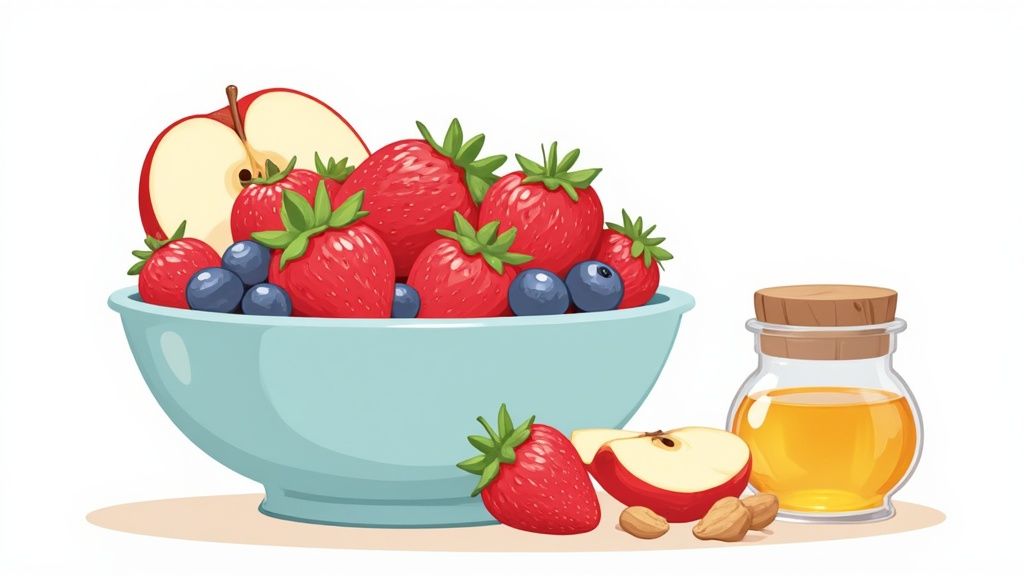
Let's face it, that initial sugar-free week can be a real challenge. Headaches, fatigue, mood swings—you might feel like you're losing your mind. It's completely normal. Thousands of people have made it through this initial hump, and so can you. This isn't a sprint; it's a journey. You'll get there! If you're looking for extra support in this first phase, our sugar detox for beginners guide might be just what you need.
Understanding the Challenge
It's really important to set realistic expectations. Your body is adapting to a huge shift, so feeling a bit off is perfectly okay. Think of it like kicking any other habit – it requires time and consistent effort. The first few days are typically the toughest, but I promise, it does get easier. I remember on my first attempt, the headaches were brutal. I almost threw in the towel, but I pushed through, and they eventually disappeared.
Practical Strategies for Success
So, how can you navigate this first week and make it a little less bumpy? Meal planning is your best friend. Prioritize foods that keep your blood sugar on an even keel. That translates to lots of protein, fiber, and healthy fats. Imagine a plate of chicken with roasted veggies, or salmon with a generous salad. These types of meals prevent the blood sugar crashes that can trigger those intense sugar cravings.
Another trick I've learned? Always have a backup plan for those moments when your willpower starts to waver. For me, it's keeping some sugar-free dark chocolate on hand or a batch of pre-made chia seed pudding. Knowing I have a satisfying, sugar-free option makes it so much easier to resist temptation.
Navigating Social Situations
Social gatherings can feel like a minefield during that first sugar-free week. Birthday cake at the office? Family dinner with dessert? It's definitely tricky. But it doesn't mean you have to become a hermit. Prepare a polite but firm response for when someone offers you a sugary treat. Something simple like, "I'm cutting back on sugar right now, but thanks!" usually does the trick.
Also, remember that this initial discomfort is temporary. While global sugar consumption continues its upward trend—reaching an estimated 175.4 million tons in the 2024-25 season and projected to climb another 1.4% the following year—your personal commitment to reducing your intake is a fantastic step. You can find more information on global sugar trends here. By understanding the challenges and equipping yourself with these strategies, you can confidently navigate those first seven days and beyond.
Finding Sugar Alternatives That Actually Deliver
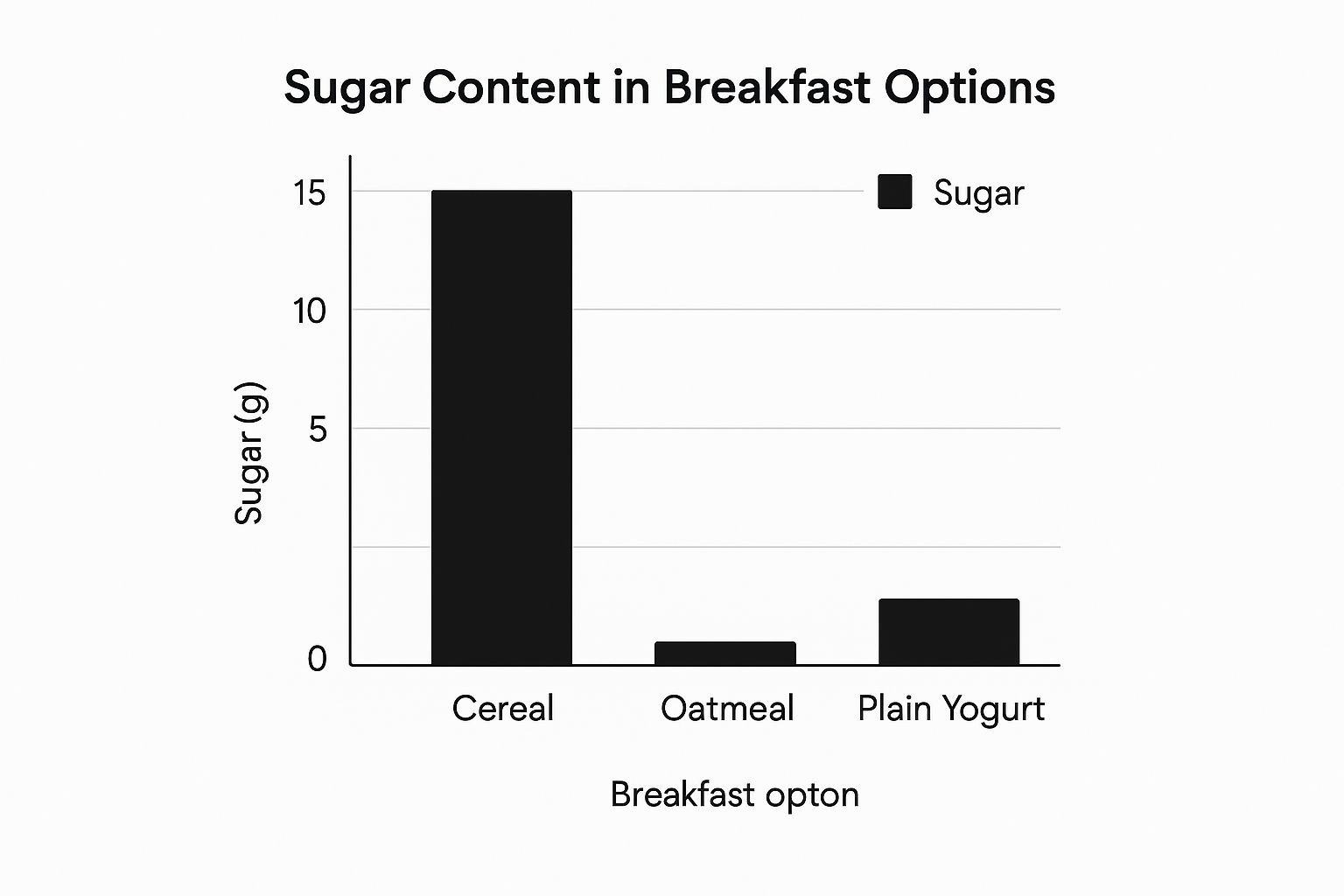
This infographic gives you a quick peek at the sugar hiding in your breakfast bowl. Notice the difference? A bowl of cereal can have a staggering 15 grams of sugar. Compare that to just 1 gram in oatmeal and 5 grams in plain yogurt. It really makes you think twice about what you're grabbing in the morning, doesn't it? Even breakfast, supposedly the most important meal, can be a sugar trap. Cutting out sugar really starts with knowing where it's hiding.
When it comes to replacing sugar, the options can be overwhelming. Trust me, I've been there. The world of sugar substitutes is always changing, and what's "healthy" one day might not be so great the next. My own experiments have had mixed results. Stevia, for example, can have a bitter aftertaste I just can’t stand, especially in coffee. But I’ve found monk fruit to be a game-changer. I use it in everything from baked goods to my morning smoothies.
Navigating the World of Sweeteners
The truth is, the best sugar alternative is the one that you like and that works for your needs. What works for me might not work for you. Some sweeteners are great for baking, some are better in drinks, and some, well, some just don't work. I’ve chatted with so many people who have tried everything under the sun, and everyone has their favorites (and their not-so-favorites). To help you out, I’ve put together a comparison table of some popular options:
To make things easier, I’ve put together a comparison table to help you navigate the world of sweeteners:
| Sweetener | Sweetness Level | Best Uses | Potential Issues | Cost Rating |
|---|---|---|---|---|
| Stevia | 200-300x sugar | Beverages, yogurt | Bitter aftertaste | $ |
| Monk Fruit | 150-200x sugar | Baking, smoothies | Can be expensive | $$ |
| Erythritol | 60-80% sugar | Baking, desserts | Can cause digestive upset in some | $$$ |
| Xylitol | Similar to sugar | Chewing gum, candies | Can cause digestive upset in some, toxic to dogs | $$$ |
| Honey | Similar to sugar | Tea, oatmeal | Higher calorie content | $$ |
| Maple Syrup | Less sweet than sugar | Pancakes, waffles | Higher calorie content | $$$$ |
This table gives you a quick overview of some popular choices, their sweetness levels, what they work best in, potential downsides, and a general idea of cost.
Beyond the Substitutes: Embracing Natural Sweetness
And don’t forget the power of naturally sweet foods! You might be surprised how much you can satisfy your sweet cravings without any added sugar at all. Think ripe berries, baked apples sprinkled with cinnamon, or even sweet potatoes. These options not only satisfy your sweet tooth but also pack a nutritional punch. The best part? Your taste buds adjust. As you cut back on sugar, you start to appreciate the natural sweetness of whole foods, making the whole process a lot easier and more enjoyable.
Creating Meals That Naturally Crush Sugar Cravings
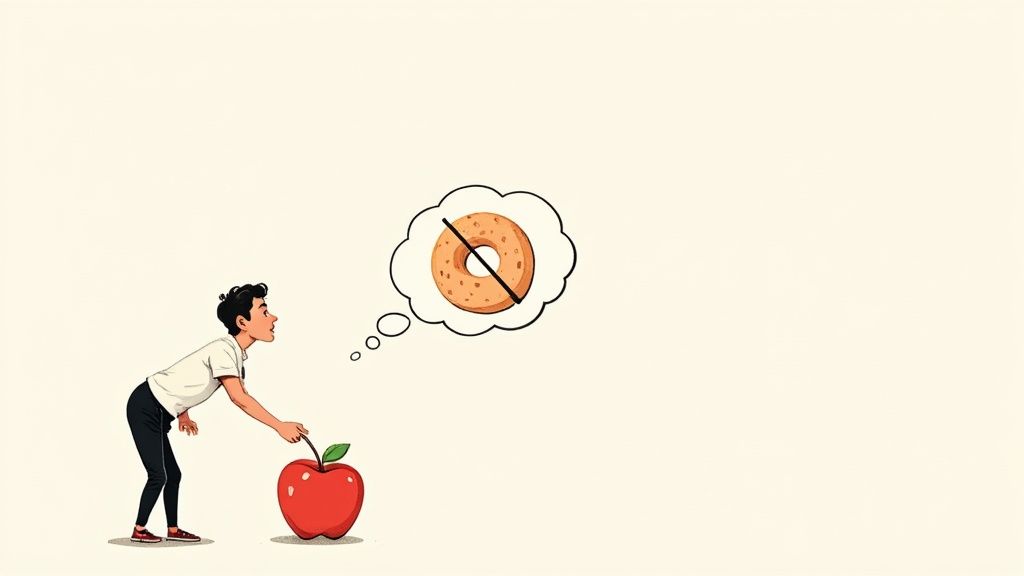
Forget about battling sugar cravings with sheer willpower. The real secret? It’s all about smart eating strategies to keep your blood sugar stable. Understanding how protein, fiber, and healthy fats work together is your key to preventing those energy crashes that send you reaching for sweets. This isn't about deprivation, trust me. It’s about nourishing your body with what it truly needs.
The Power Trio: Protein, Fiber, and Healthy Fats
This combination is incredibly powerful. Protein helps stabilize your blood sugar and keeps you feeling full and satisfied. Fiber slows down digestion, preventing those rapid blood sugar spikes and dips. And those healthy fats? They bring flavor and make your meals more satisfying, so you feel content long after you’ve finished eating. Together, these nutrients are like a dream team for balanced blood sugar. Think about it: instead of a bowl of sugary cereal for breakfast, how about some eggs with avocado and whole-wheat toast? The eggs offer protein, the toast has fiber, and the avocado provides healthy fats. That's sustained energy and goodbye mid-morning cravings.
Meal Prep: Your Secret Weapon
Now, I know what you’re thinking: "This sounds complicated!" It really doesn’t have to be. Meal prepping is your game-changer. Spending a few hours on the weekend prepping ingredients, or even entire meals, saves you so much time and stress during the week. Roast a big pan of vegetables, cook up some quinoa or brown rice, and grill some chicken or fish. Mix and match these throughout the week for quick, satisfying lunches and dinners. This is my go-to strategy for staying on track, even when things get hectic.
20-Minute Meals That Don’t Taste Like Diet Food
Another myth about ditching sugar is that you’re doomed to boring, tasteless meals. So not true! There are so many delicious, sugar-free recipes that are quick and easy to prepare. One of my personal favorites is a stir-fry with lean protein, tons of colorful veggies, and a simple sauce made with tamari, ginger, and garlic. It's bursting with flavor and ready in under 20 minutes.
Outsmarting the Sugar Roller Coaster
The best way to avoid sugar binges? Avoid the blood sugar roller coaster altogether. By eating regular, balanced meals that include the power trio of protein, fiber, and healthy fats, you’ll keep your blood sugar steady and prevent those intense cravings. The StopSugar app can also be a huge help. It lets you track your meals, monitor your cravings, and find healthy alternatives when those sweet urges hit. Think of it as your personal pocket coach.
Even with the best plans, sometimes life throws you a curveball. Maybe you miss a meal, get stuck in a long meeting, or just don't have the energy to cook. That's perfectly fine! Having some backup options on hand is key. Keep some nuts, seeds, or hard-boiled eggs around for those emergency moments. They’re quick, easy, and will tide you over until you can have a proper meal. By combining smart meal planning, practical prep strategies, and the support of the StopSugar app, you'll be ready to conquer the challenge of cutting out sugar and build a healthier, more balanced relationship with food.
Mastering Sugar-Free Social Situations With Confidence
Navigating social gatherings when you've ditched sugar can sometimes feel like a minefield. Birthday cakes, holiday treats, and the well-meaning friend who insists just one bite won't hurt... Been there, done that, got the (sugar-free) t-shirt. But trust me, it is totally possible to enjoy these events without feeling deprived or like you're constantly on the defensive.
Handling the "Just One Bite" Pressure
Let's be real, the "just one bite" crew is everywhere. Usually, it's paired with enthusiastic cries of "It's so good!" and "You have to try this!" Honestly, a polite but firm "No, thank you, I'm cutting back on sugar" usually does the trick. If they're particularly persistent, a simple "I really appreciate the offer, but I'm good" shuts it down without making a big fuss. I used to feel like I had to justify myself, but I've realized a short, sweet "no" is the most effective strategy.
Navigating Workplace Celebrations
Office birthdays, holiday parties, and that communal candy jar can be a real test of willpower. One thing I've found helpful is bringing my own sugar-free treat. This way, I'm not feeling left out while everyone else indulges. Another trick is strategic positioning. Hovering near the veggie platter or the water cooler helps avoid the constant barrage of sugary temptations.
Dining Out Without the Interrogation
I used to dread eating out, feeling like I was going to have to explain my dietary choices to the entire waitstaff. Now, I just plan ahead. Checking the menu online beforehand helps me scope out sugar-free options. And I'm not shy about asking for modifications. Most restaurants are happy to accommodate simple requests like dressing on the side or swapping out sugary sauces. A simple "Could I have this without the glaze?" or "Could you substitute steamed vegetables for the fries?" works wonders.
Potlucks and Parties: Bringing the Deliciousness
Potlucks are a fantastic opportunity to show off how amazing sugar-free food can be. Bringing a dish that everyone will enjoy, not just those avoiding sugar, totally changes the game. Think a vibrant salad with a homemade vinaigrette, roasted veggies bursting with flavor, or even a sugar-free dessert made with alternative sweeteners. You'll be surprised how many compliments you get!
Building Your Support System
This is probably the most important tip. Surround yourself with people who get it. Sharing your journey with friends, family, or an online community like the one on the StopSugar app makes a world of difference. Having a network who understands your goals and won't tempt you with treats makes the journey so much easier. Remember, social situations don’t have to be obstacles. They can be opportunities to show everyone just how delicious and satisfying a sugar-free life can be.
Building a Sugar-Free Life That Actually Lasts
This isn't about gritting your teeth through a short detox and then falling back into old habits. It's about building a sugar-free life you can actually live—one that adapts to work stress, holidays, family emergencies, and everything else life throws at you. This means ditching the all-or-nothing mindset and embracing a sustainable approach that changes with you.
Long-Term Strategies For Success
People who have successfully stayed sugar-free for years often talk about the importance of focusing on the why. Why did you decide to cut out sugar in the first place? Was it for more energy? Better sleep? Keeping your initial motivation top of mind can really help you stay on track when that initial burst of enthusiasm fades. For me, it was about feeling more in control of my eating habits. That feeling has been huge, especially when things get tough.
Handling Slip-Ups Without the Shame Spiral
Let’s be real, slip-ups happen. The key is to avoid beating yourself up and using one mistake as an excuse to give up completely. Instead, recognize the slip-up, understand why it happened, and get right back on track. One strategy I use is having a plan for cravings before they hit. Knowing I have a healthy, sugar-free option ready makes resisting temptation so much easier.
Reintroducing Treats (Yes, Really!)
Eventually, you might choose to bring back the occasional treat. This isn't about returning to your old sugar-filled ways, but about enjoying a treat mindfully, without falling back into old patterns. One approach is focusing on quality over quantity. Choose a small portion of something truly delicious and savor each bite. This can be surprisingly satisfying and helps avoid that feeling of deprivation that often leads to overeating. You might find this interesting: Benefits of Quitting Sugar.
Tracking Progress Beyond the Scale
While the scale can be a useful tool, it’s not the only way to measure your success. Pay attention to how you feel. Are you sleeping better? Do you have more energy? Are your clothes fitting differently? These non-scale victories are really motivating and can be even more rewarding than seeing a lower number on the scale.
Adapting to Changing Tastes
As you eat less sugar, your taste buds will actually change. Foods you used to find bland might start tasting amazing. Embrace this! Use it to your advantage. Experiment with new recipes and explore the world of herbs, spices, and other flavors that can make your meals exciting without any added sugar. This whole journey is about building a lasting and enjoyable way of eating that supports your long-term health and well-being.